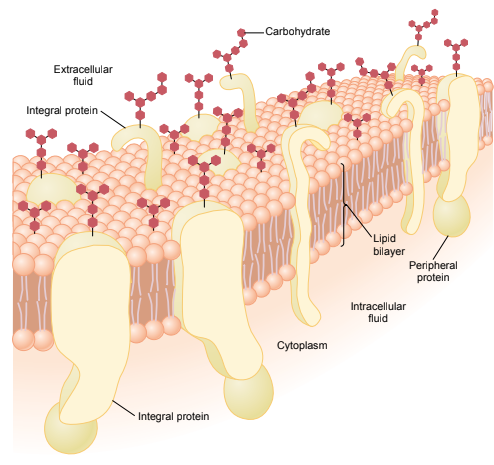Makindo Medical Notes"One small step for man, one large step for Makindo" |
|
|---|---|
| Download all this content in the Apps now Android App and Apple iPhone/Pad App | |
| MEDICAL DISCLAIMER: The contents are under continuing development and improvements and despite all efforts may contain errors of omission or fact. This is not to be used for the assessment, diagnosis, or management of patients. It should not be regarded as medical advice by healthcare workers or laypeople. It is for educational purposes only. Please adhere to your local protocols. Use the BNF for drug information. If you are unwell please seek urgent healthcare advice. If you do not accept this then please do not use the website. Makindo Ltd. |
The Cell membrane
-
| About | Anaesthetics and Critical Care | Anatomy | Biochemistry | Cardiology | Clinical Cases | CompSci | Crib | Dermatology | Differentials | Drugs | ENT | Electrocardiogram | Embryology | Emergency Medicine | Endocrinology | Ethics | Foundation Doctors | Gastroenterology | General Information | General Practice | Genetics | Geriatric Medicine | Guidelines | Haematology | Hepatology | Immunology | Infectious Diseases | Infographic | Investigations | Lists | Microbiology | Miscellaneous | Nephrology | Neuroanatomy | Neurology | Nutrition | OSCE | Obstetrics Gynaecology | Oncology | Ophthalmology | Oral Medicine and Dentistry | Paediatrics | Palliative | Pathology | Pharmacology | Physiology | Procedures | Psychiatry | Radiology | Respiratory | Resuscitation | Rheumatology | Statistics and Research | Stroke | Surgery | Toxicology | Trauma and Orthopaedics | Twitter | Urology
Related Subjects: |DNA replication |The Nucleus |Mitosis and Meiosis |Ribosomes |Microtubules |Mitochondria |Smooth and Rough Endoplasmic Reticulum |Sodium Potassium ATPase pump |The Cell membrane
🧫 The cell membrane (plasma membrane) is a dynamic, selectively permeable barrier that surrounds every cell. It regulates movement of substances in/out, preserves cellular integrity, and enables communication and recognition between cells. Think of it as the "security system + interface" of the cell. 🔑
🧬 Structure
- Phospholipid Bilayer: Foundation of the membrane.
- 💧 Hydrophilic heads face outward (towards aqueous environment).
- 💨 Hydrophobic tails face inward, forming a nonpolar barrier that blocks most polar molecules.
- Proteins: Essential for function and transport.
- 🔗 Integral proteins: Span the bilayer, acting as channels, pumps, and receptors.
- ⚙️ Peripheral proteins: Loosely attached, providing support, anchorage, and signalling roles.
- Cholesterol: 🧴 Inserts between phospholipids.
- Stabilises membrane fluidity — prevents rigidity in cold and excess fluidity in heat.
- Carbohydrates (Glycocalyx): 🍬 Found as glycoproteins & glycolipids on outer surface.
- Enable cell recognition (immune self vs non-self).
- Protects membrane, aids adhesion, and mediates immune response.

⚡ Functions
- Selective Permeability: 🚪 Controls entry/exit of molecules, blocking harmful agents while allowing nutrients and ions.
- Transport Mechanisms:
- 🌬️ Passive: Diffusion & facilitated diffusion → down gradient, no ATP needed.
- ⚡ Active: Requires ATP → pumps ions/molecules against gradient (e.g. Na⁺/K⁺ ATPase).
- Cell Communication: 📡 Surface receptors bind hormones, neurotransmitters → trigger signalling cascades.
- Cell Recognition: 🧾 Glycocalyx tags identify cell type → critical for immunity, development, and tissue organisation.
- Structural Support: 🏗️ Anchors to cytoskeleton → maintains shape, stabilises cell–cell junctions.
🩺 Clinical Relevance
- 🫁 Cystic Fibrosis: Defective CFTR channel → abnormal Cl⁻ transport → thick mucus, lung infections.
- 🩸 Diabetes: Faulty insulin receptor signalling → impaired glucose uptake.
- 🎯 Cancer: Mutations in membrane receptors (e.g. EGFR) → uncontrolled growth signalling.
- 🛡️ Immune defence: Glycocalyx enables immune system to distinguish self vs pathogen.
📌 Summary
🔑 The cell membrane is more than a barrier — it’s an active, intelligent system. It preserves cell integrity, regulates exchange, and mediates communication, adhesion, and recognition. Disruption of its structure or signalling underlies major diseases, from cystic fibrosis to cancer.